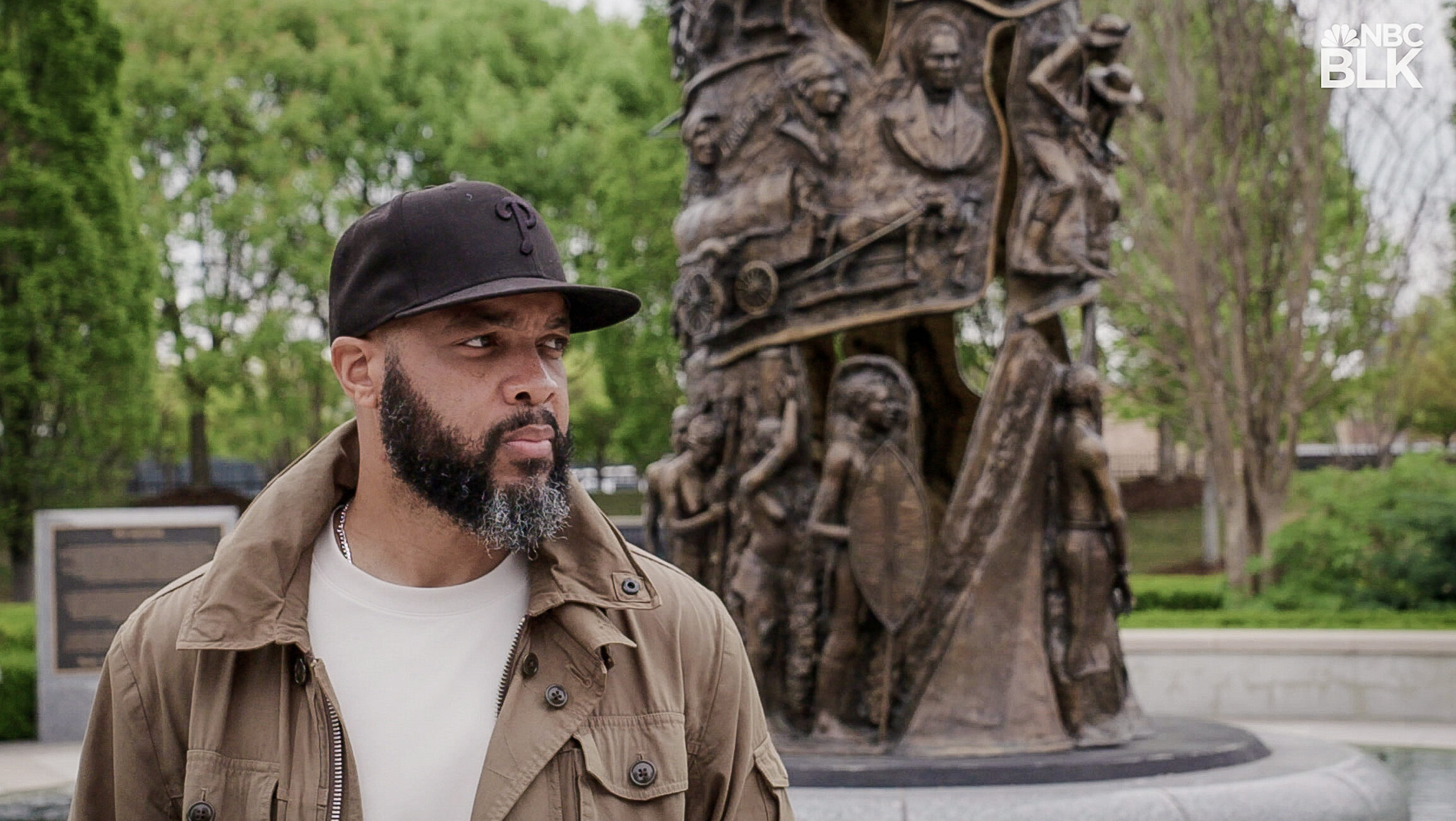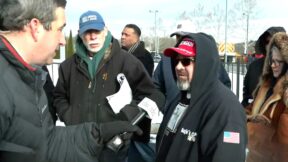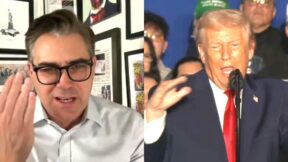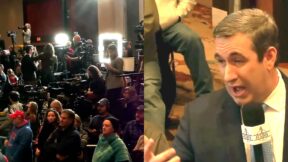‘A Conspiracy of Silence’: MSNBC’s Trymaine Lee Hosts Documentary on Legacy of 1921 Tulsa Massacre

MSNBC’s Trymaine Lee. Photo by Ernesto Guadalupe.
The deadly 1921 attack on the Greenwood district of Tulsa, Oklahoma, known then as America’s “Black Wall Street,” killed hundreds of people, left thousands homeless, and utterly destroyed a prosperous community of Black business-owners and families. Over just a few days in late May and early June, a mob of White people, armed with weapons, airplanes, firebombs, and the support of local government and law enforcement, descended on Greenwood following news of a false allegation that a Black man, Dick Rowland, assaulted Sarah Page, a White woman, in an elevator.
In the aftermath, what was left were the remnants of smoldering buildings, piles of rubble – and a century-long legacy of descendants trying to have their ancestors’ stories heard, despite ongoing attempts to bury the story of what happened in Greenwood, both figuratively and literally.
MSNBC’s Trymaine Lee, in his documentary Blood on Black Wall Street: The Legacy of the Tulsa Massacre, reports on the deadly events that began on May 30, 1921, and the deep wounds that remain today.
“I’ve long known about the Tulsa race massacre. That was a bloody day, a shameful day, a stain on American history. But it wasn’t really until I got to Tulsa that I could really get my arms around the generational trauma,” Lee told Mediaite.
Lee knows that many Americans have only a passing knowledge of the attack.
“I think this is one of those stories where people in this country simply just haven’t been aware of this. I think as a journalist, and as a Black journalist in particular, I’ve always been on a mission to kind of shine a light in dark spaces. And I think this exemplifies that.”
As Lee reports, Americans’ superficial knowledge of the massacre isn’t by accident – starting with the massacre itself, as well as the aftermath.
“It was all cosigned by local officials,” Lee said. “The police literally deputized White citizens. They dropped bombs from the air.”
Afterwards, Lee said, the attack wasn’t discussed. It wasn’t taught in schools. Newspaper accounts from the time – “those that weren’t inciting or egging on the violence,” Lee said – disappeared from libraries.
“There’s this conspiracy of silence that is almost shocking,” Lee said. “The media helped cover it up. The teachers helped cover it up. The perpetrators covered it up. But everyone knows.”
And the conclusion that local authorities “buried the story” isn’t just a metaphor.
“They literally buried the story,” Lee said. “The search for where the remains of those victims lie today is still being obstructed.”
As Lee’s documentary also reveals, even survivors themselves didn’t talk about it. One descendant shared that her grandmother told her that survivors of the massacre couldn’t even discuss it without risking their lives.
“That moment, that family’s story, I think shook me the most, perhaps,” Lee said. “Thinking about a nine-year-old girl, experiencing bullets raining down from the sky, and buildings being burned and people being murdered and hiding in a chicken coop, and then all those years after the massacre, she never talked about it with her family … The burden of carrying that around, the trauma – that was heavy for me.”
“On one side you have a Black community so traumatized by the violence that they dare not speak about it out of fear they’ll do it again, because all of the perpetrators got away with it, every single one of them,” Lee continued. “Everyone knew what happened, and they had to live in proximity to the same people who murdered their family and their neighbors. On the other hand, you have a White community that had largely intentionally buried the story.”
Lee’s documentary also addresses how decades of efforts to rebuild Greenwood have been stymied.
“Every attempt to rebuild was blocked,” Lee said, adding that every local administration has refused to fund any kind of excavation or investigation of where the victims’ bodies remain, until now.
“G.T. Bynum, the current Republican mayor, is the first mayor in a generation to fund any excavation,” Lee said. “He’s actually moved the ball forward, and accepted this demand that the community has been calling for in many, many years. He’s the first one to do anything about it.”
But repairing the damage won’t end with identifying the remains of those who perished.
“The long-cast shadow still touches people to this day,” Lee told Mediaite. “You look at the Black unemployment rate, it’s twice that of Whites. You look at the 200 Black-owned businesses that existed in 1921 before the massacre, and less than two dozen today. The poverty rate, double. And you can connect the dots to those early days of the massacre.”
Lee’s documentary is part of NBC and MSNBC’s extensive coverage of the Tulsa massacre. Tulsa: The Massacre and The Movement includes coverage of the attack and its aftermath, including reports from anchor Lester Holt on NBC Nightly News, correspondent Harry Smith and anchor Sheinelle Jones on the Today Show, and anchor Tiffany Cross on MSNBC’s Cross Connection, as well as features on Weekend Nightly, Sunday Today, NBC News Digital, and CNBC.
Lee told Mediaite that he believes that the network’s wide-ranging coverage is, in part, a response to the racial and social justice movements that took hold over the past year.
“There’s no doubt in my mind that we’re at a place in America where we’ve had to grapple with so much for so long, I think we now have the language to talk about it,” Lee said. “After the murder of George Floyd, with everyone witnessing that and understanding that this was a murder, and part of a broader system of violence, I think we’re now in a place where people are able to receive this in a different way.”
Lee also said that NBCUniversal News Group chairman Cesar Conde and MSNBC President Rashida Jones, who just stepped into the role in February, are making good on their word to “more fully telling the big story of America, of being inclusive.” NBC News president Noah Oppenheim is also said to have played a major role in the multi-platform coverage.
At the same time, Lee said that both journalists and descendants of the survivors of the massacre have been trying to tell this particular story, and stories like it, for a long time, with varying degrees of success.
“Many people in Tulsa, even with the attempt to bury the story, had always been making some noise,” Lee said. “People knew there were survivors or descendants of those who were killed. Those folks had always been pushing, but they were always just silenced. Hopefully with this documentary, and the podcast, and the broader push from NBC and MSNBC, hopefully these voices will finally, finally be heard.”
Lee, who first became aware of the Tulsa massacre after watching the movie Rosewood, based on the deadly attack by a White mob on a prosperous Black community in Florida in 1923, knows that there are more stories like this that need to be told.
“We think about the hallowed ground of Tulsa,” Lee said. “But this entire country is filled with hallowed ground. Hallowed ground where unspeakable acts have happened. Some we know about, some we don’t. Some whispered about, some passed down through lore through generations.”
“This is where we are now, trying to reckon with who we say we’ve been and who we’ve really been, because there’s no way we’re ever going to move forward in this country, in any semblance of peace and justice or any of the ideals that we say we aspire to, without reckoning with that past,” Lee continued. “Because we’re carrying that. We’re carrying that with us, both as inherited trauma, but those who are keeping those secrets of their ancestors who committed those acts.”
As a reporter, Lee has covered stories about social justice issues and the intersection of race, violence, politics and law enforcement. But for him, reporting on the Tulsa massacre and its legacy carried a different type of emotional weight.
“This story had so many layers to it that it was hard to tell, in some ways, because of the emotional resonance,” Lee said. “But on the other hand, it was an honor and a privilege to help amplify the voices of people in this community, for them to tell their story in an honest, truthful way.”
“This is what we do, and it’s an opportunity to educate America,” Lee added. “To connect the past with the present, to let people have a glimpse into this community and the long-cast ripples of what happened 100 years ago, and to highlight their strength and moving forward in their fight, but also that great sense of loss.”
For journalists seeking to report on previously-untold stories of racial violence, Lee emphasized the need to be steadfast.
“I think we have to be unflinching,” Lee said, noting that sometimes journalists want to “overcorrect” for the audience out of a desire to not offend anyone. “But when it comes to the actual experiences of Americans and Black Americans in particular, knowing how muted those voices have been, I think we have to be unflinching and we have to tell the truth.”
Lee also said that context is crucial. “It’s not just about violence, but that the violence was intentional,” Lee said. “The government was complicit in a lot of this. Whether we’re talking about the stripping of wealth, the stripping of livelihood, or the stripping of freedom, the government was right there, side by side the entire way. So we want to understand the big machine here. We have to push into the cogs and be honest and open. We have to push hard.”
Blood on Black Wall Street: The Legacy of the Tulsa Massacre streams Friday on NBCNews.com, and will air Sunday on MSNBC at 10 p.m. ET, as well as CNBC at 2 p.m. ET. The documentary will also be available on NBC’s streaming service Peacock.
In addition to the documentary, Lee also hosts a special two-part episode of his Into America podcast, which will look more closely at the financial impact of the Tulsa massacre on local Black families, as well as the efforts of White Tulsa residents as they face their families’ past. Part one is currently available, and part two will be available on Thursday, June 3.




